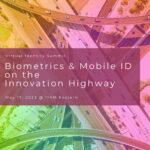The next FindBiometrics Virtual Identity Summit is just around the corner, and as its name implies, “Biometrics and Mobile ID on the Innovation Highway” is all about the ideas and technologies at the leading edge of our industry. HID is the Silver Sponsor for the event and was recently recognized as an innovation and growth leader on the 2022 Frost Radar for Biometric Authentication. That’s why FindBiometrics reached out to Vito Fabbrizio, Managing Director of HID’s Biometric Business Unit, to learn more about how innovation plays a role in the company’s business strategy, particularly in the air travel arena, and what our industry can do to address the challenges that lie ahead for biometrics and identity.
Read our full interview with Vito Fabbrizio, Managing Director, HID, Biometric Business Unit:
FindBiometrics: The recently released 2022 Frost Radar for Biometric Authentication positions HID as an innovation and growth leader. It highlights your company’s robust multimodal biometric product portfolio, as well as HID’s embrace of crucial identity technologies like liveness detection. How has HID prioritized innovation in biometrics? And what role does innovation play in HID’s larger strategy for biometrics and digital identity?
Vito Fabbrizio, Managing Director, HID, Biometric Business Unit: Innovation is the driving force behind the strategic vision for HID products. New technologies help to create better customer experiences and more secure methods to access places, data and services without sacrificing the ease of use. Our long-term competitive advantage is achieved through a combination of continuous improvements and breakthrough technology leaps.
The guiding principles for what and how we develop at HID are: (1) Do the right things, (2) Do things right. It sounds simpler than it is. We focus on building an organization that values innovation and provides the tools needed to achieve that vision:
- Culture of innovation: Foster creativity and encourage experimentation to unlock new technologies.
- Employee empowerment: Allow employees the freedom to formulate new ideas, take risks and explore new concepts and solutions.
- Stakeholder and industry insights: Understand market drivers and how our products and solutions can better meet the real-world challenges of customers, partners and regulators.
- R&D investment: Innovate for long-term growth by building new technologies that solve industry problems in the future.
- Goal setting and measurement: Define clear innovation goals and track the progress to ensure the company stays on the right track.
HID’s innovation and growth leadership goes beyond improving the accuracy and speed of existing technologies and ensuring our solutions meet customer requirements – it’s our determination to push the innovation boundaries of the biometrics authentication industry forward. Innovation keeps HID technologies ahead of the curve and our customers satisfied.
FindBiometrics: We’re seeing more and more digital transformation in the air travel industry, with things like biometric passenger screening and mobile check-in options popping up around the world. Where do you think this trend is headed as the industry recovered from the disruption of the pandemic?
Vito Fabbrizio, Managing Director, HID, Biometric Business Unit: Digital transformation in the air travel industry is likely to accelerate as we continue to recover from the pandemic. People are ready to restart their travel. The industry overall has seen productivity gains and customer experience enhancements from advanced screening technologies, such as AI-powered facial recognition and blockchain technologies, which we expect will continue to expand.
Airlines and airports are pursuing more self-services, contactless solutions for ticketing/boarding, and baggage check-in to streamline travel. We’re seeing biometric and mobile check-in options simplify the process and provide a more secure passenger screening experience.
AI is also taking center stage for the air travel industry by shifting toward personalized, customer-centric services. Understanding the customer and connecting with them directly with traveler-specific recommendations, chatbots and virtual reality enables a better experience for everyone.
FindBiometrics: HID offers a range of products and solutions, many of which can be combined depending on the needs of a given deployment. How do you help clients and potential customers understand what solutions best fit their needs, especially for more complex projects?
Vito Fabbrizio, Managing Director, HID, Biometric Business Unit: Every customer engagement begins by understanding their unique environment and challenges. HID partners with customers to define their objectives and timeline, then develop a solution with a range of options tailored to their needs and budget. The pros and cons of each recommendation are discussed to ensure the ideal biometrics authentication solution is developed to help our customers achieve their goals.
Once a solution is scoped, HID outlines the process of implementing the solution – from start to finish. It is essential for the customer to understand each step in the implementation and what’s required from them. We never walk away from a project until a customer is completely satisfied with the solution and is comfortable with the process. We always follow up with each customer after the project is finished to confirm that they are happy with the results. It’s about customer care for HID.
FindBiometrics: The biometrics industry has advanced by leaps and bounds over the past couple of decades, but it’s still facing obstacles in a range of areas. What do you see as the biggest challenges in the road ahead for biometrics, and how do you think the industry can best meet them?
Vito Fabbrizio, Managing Director, HID, Biometric Business Unit: The challenges facing the biometrics industry relate to both technology and customer adoption. Fast, accurate and easy to use digital identity solutions benefit a wide range of industries that are just realizing the potential. There are a few challenges that we are focused on resolving:
- Security: Authentication protocols and network-wide security must be up to date to protect sensitive data effectively. Biometric data should always be encrypted, stored securely and authenticated with the right levels of accuracy and speed.
- Privacy: Although customer data privacy is complex, a properly implemented identity management system following best privacy practices, such as encryption, anonymous templates and tokenization, will help comply with the regulations. Companies need to be transparent about their data collection practices. Implementing self-sovereign identity allows users to manage their own consent and provide an opportunity to opt out.
- Technology Performance: One of the biggest challenges for biometrics authentication technology is the matching speed and accuracy needed against matching bias – especially with different demographics and age ranges. AI offers an opportunity to overcome the matching limitation.
- Cost: The cost of biometric authentication systems can be a barrier for adoption. Exploring cost-effective technologies is necessary to make biometrics authentication solutions accessible to a wider range of customers.
- Usability: Implementing and managing overly complex systems can deter companies from adopting biometrics authentication solutions. Concern over manageability can prevent this essential security measure from being deployed and the opportunity to create seamless user experiences.
- Scalability: Biometrics solutions that can scale are required to meet the needs of a broad range of customers. Use cases for biometrics authentication will continue to expand. As new solutions enter the market, customers need the flexibility to leverage the strengths of multiple technologies from one central platform.
HID is a sponsor of the upcoming online event, “Biometrics and Mobile ID on the Innovation Highway.” Check out the agenda and reserve your seat today.
Want to hear more from Vito Fabbrizio, Managing Director, HID, Biometric Business Unit? Watch this panel discussion on contactless biometric payments in retail.








Follow Us